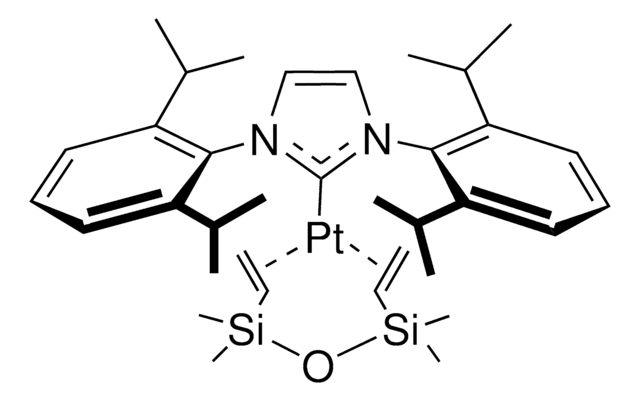479519
Platinum(0)-1,3-divinyl-1,1,3,3-tetramethyldisiloxane complex solution
in xylene, Pt ~2 %
Synonym(s):
Karstedt′s catalyst, Platinum(0) 1,3-diethenyl-1,1,3,3-tetramethyldisiloxane complexes
About This Item
Recommended Products
vapor pressure
7 mmHg ( 21 °C)
composition
Pt, ~2%
reaction suitability
core: platinum
reagent type: catalyst
concentration
in xylene
bp
138 °C
mp
12-13 °C
density
0.855 g/mL at 25 °C
SMILES string
[Pt].C[Si](C)(O[Si](C)(C)C=C)C=C
InChI
1S/C8H18OSi2.Pt/c1-7-10(3,4)9-11(5,6)8-2;/h7-8H,1-2H2,3-6H3;
InChI key
RCNRJBWHLARWRP-UHFFFAOYSA-N
Looking for similar products? Visit Product Comparison Guide
Related Categories
General description
Application
It has also been used in the reduction of carboxamides to amines.
Signal Word
Danger
Hazard Statements
Precautionary Statements
Hazard Classifications
Acute Tox. 4 Dermal - Acute Tox. 4 Inhalation - Aquatic Chronic 3 - Asp. Tox. 1 - Eye Irrit. 2 - Flam. Liq. 3 - Skin Irrit. 2 - STOT RE 2 Inhalation - STOT SE 3
Target Organs
Central nervous system,Liver,Kidney, Respiratory system
Storage Class Code
3 - Flammable liquids
WGK
WGK 3
Flash Point(F)
77.0 °F - closed cup
Flash Point(C)
25 °C - closed cup
Certificates of Analysis (COA)
Search for Certificates of Analysis (COA) by entering the products Lot/Batch Number. Lot and Batch Numbers can be found on a product’s label following the words ‘Lot’ or ‘Batch’.
Already Own This Product?
Find documentation for the products that you have recently purchased in the Document Library.
Customers Also Viewed
Articles
Trost group's protocol yields α-vinylsilanes from terminal acetylenes using [Cp*Ru(MeCN)3]PF6 catalyst and others for hydrosilylation.
Our team of scientists has experience in all areas of research including Life Science, Material Science, Chemical Synthesis, Chromatography, Analytical and many others.
Contact Technical Service













